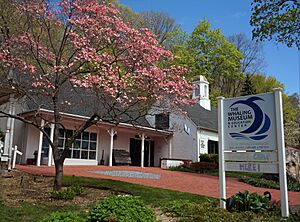- This page was last modified on 17 October 2025, at 10:18. Suggest an edit.
The Whaling Museum & Education Center facts for kids
 |
|
| Former name | The Whaling Museum |
|---|---|
| Established | 1942 |
| Location | Cold Spring Harbor, New York |
| Type | History museum |
| Accreditation | American Alliance of Museums |
| Collection size | 6,000 |
| Visitors | 20,000 annually |
| Owner | The Whaling Museum Society |
The Whaling Museum & Education Center is a cool place to visit in Cold Spring Harbor, New York. It used to be called The Whaling Museum. This museum teaches you all about the history of whaling, especially how it affected Long Island. It also shares stories about the local area and its connection to the sea.
About 20,000 people visit the museum every year. It's a special museum because it's approved by the American Alliance of Museums. The group that runs the museum, The Whaling Museum Society, started in 1936. The museum itself opened its doors in 1942.
The museum has a lot of interesting things to see. It holds about 6,000 items, including old papers and artifacts. Many of these come from Cold Spring Harbor and other towns on Long Island that were involved in whaling. You can see a real 19th-century whaleboat with its original tools. There's also a huge collection of scrimshaw, which are artworks made by whalers.
Other displays show tools used for whaling and parts of old ships. You can also learn about navigation and see cool ship models. The museum has a library with many books and old letters. These documents tell stories about the Cold Spring whaling fleet. They include ship logs, journals, and business letters from the Cold Spring Whaling Company. You can also find records from the Cold Spring Harbor Customs House, which was open from 1798 to 1908.
The museum always has fun events and exhibits. They show films, host talks, and put on special performances. These events help connect whaling to other topics like art, science, and different cultures.
Discover the Museum's Amazing Collection
The museum's collection has grown over many years. People from the community have donated items since the museum started in 1936. There are 6,000 pieces in total. Most of these items tell the story of the 19th-century whaling industry. They also show how Cold Spring Harbor grew as a busy port town.
Here are some of the cool things you can find:
- Scrimshaw Art: There are 500 scrimshaw items. These are beautiful artworks made by whalers while they were at sea. They carved designs onto whale teeth and tusks. The collection also has many useful items like sewing boxes and tools.
- Whaling Tools and Ship Gear: You can see 275 different tools. This includes a real 19th-century whaleboat from a Long Island whaleship called Daisy. It's the only fully equipped whaleboat in New York State with its original gear! There are also tools, a large pot for melting blubber, and navigation instruments.
- Old Records and Archives: The museum has almost all the old papers from the Cold Spring Harbor whaling fleet. These documents cover 44 voyages of 9 ships from 1836 to 1862. You can read 15 ship logs and 12 journals. There are also business letters and records from the local Customs House. You can even see photos of crew members and ships.
- Richmond Collection: This special collection includes papers, letters, and receipts from the Cold Spring Harbor ship Richmond. This ship was wrecked in 1849. These documents are important because they were part of a big legal case about saving things from shipwrecks. The museum got this collection in 2012.
- Ship Models: There are 12 detailed models of whaling ships. One was made by a famous model maker named Henry Culver. You can also see a huge diorama, which is a 3D model, of Cold Spring Harbor in 1850. It's 48 inches by 72 inches and was finished in 1970.
- Marine Art: The museum has 150 paintings, prints, and old photographs. These artworks show scenes of whaling and ships. Some pieces are by famous artists like Currier & Ives.
- Daily Life Items: You can see 6 old costumes and 50 whale oil lamps. There are also accessories and everyday objects from the 1850s. These were donated by local whaling families. You might see a ship in a bottle, old glass bottles, and kitchen tools.
- Natural History: This section has 25 whale bones. You can also see 2 narwhal tusks, a sperm whale jaw, and an orca skull. There are other parts of ocean animals, like coral.
- Hewlett Collection: This collection came from John D. Hewlett in 1989. It has over 200 photos and 300 letters. These items show how Cold Spring Harbor grew as a port. There are also paintings of local landscapes and portraits of citizens.
- Hoie Collection: In 2012, the museum received 24 watercolor paintings by Claus Hoie. He was a Long Island artist who painted many whaling scenes.
Cold Spring Harbor's Whaling Past
In 1932, some people living in Cold Spring Harbor wanted to remember their village's past. It was once a very important whaling port. So, they asked for a monument to be built. A large boulder was pulled from the harbor and placed in the village square. It has the names of the nine whaling ships from the fleet carved on it. Later, this monument was moved to the museum's property, where you can see it today.
